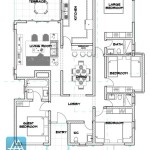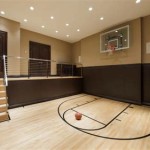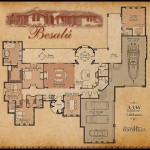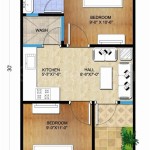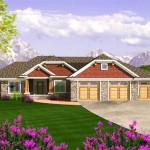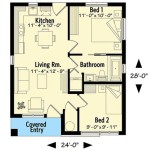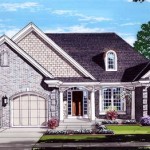Single Story House Plans With Cathedral Ceilings: Design, Benefits, and Considerations
Single story house plans, often lauded for their accessibility and ease of maintenance, gain a heightened sense of spaciousness and architectural interest when paired with cathedral ceilings. These vaulted ceilings, characterized by their soaring heights and often sloped design that mirrors the roofline, introduce natural light, create an open atmosphere, and elevate the overall aesthetic appeal of a home. This article explores the diverse aspects of single story house plans incorporating cathedral ceilings, including design considerations, advantages, important planning factors, and potential challenges.
The Allure of Cathedral Ceilings in Single Story Homes
The primary draw of a cathedral ceiling lies in its transformative effect on the perceived volume of a room. Even in a relatively modest single story home, a vaulted ceiling can dramatically expand the sense of space, making the area feel grander and more airy. This is particularly advantageous in living rooms, dining areas, and master bedrooms, where a feeling of openness is highly desirable. Furthermore, the increased height allows for larger windows, which can significantly enhance natural light penetration, reducing reliance on artificial lighting and creating a brighter, more inviting interior.
Beyond the practical benefits, cathedral ceilings add a distinct architectural flair. They can be designed in various styles to complement the overall aesthetic of the house, from traditional to contemporary. Exposed beams, decorative trusses, or tongue-and-groove paneling can be incorporated to create visually striking features that enhance the character of the space. The added height also provides opportunities for unique lighting fixtures, such as chandeliers or pendant lights, which can serve as focal points and contribute to the overall ambiance of the room.
Key Design Considerations for Single Story Homes with Cathedral Ceilings
Designing a single story home with cathedral ceilings requires careful planning and attention to detail. The slope of the ceiling, the size and placement of windows, and the choice of materials all play a crucial role in achieving the desired aesthetic and functional outcome. Here are some crucial design aspects to consider:
Ceiling Slope and Style: The slope of the cathedral ceiling significantly impacts the overall feel of the room. A steeper slope will create a more dramatic and expansive effect, while a gentler slope may feel more subtle and integrated. Common styles include symmetrical cathedral ceilings, where both sides of the roof slope equally, and asymmetrical designs, which can add a unique architectural element. Hammerbeam trusses, exposed rafters, or even a simple vaulted shape are other stylistic choices that can emphasize the ceiling's character.
Window Placement and Size: As height increases so does the location and quantity of the windows. Windows located higher up on the wall helps to amplify light. The inclusion of transom windows creates a visual dimension and also filters light into the space. The size of the windows dictates the level of natural light the area can harness. Integrating clerestory windows, which are set high near the ceiling, allows for additional light without compromising privacy. Proper window placement will improve natural lighting and increase thermal efficiency saving costs on utilities.
Insulation and Ventilation: Proper insulation is paramount in homes with cathedral ceilings. Due to the increased surface area and potential for heat loss or gain, effective insulation is necessary to maintain comfortable temperatures and minimize energy consumption. Spray foam insulation, rigid foam boards, and batt insulation are all viable options, depending on the specific design and climate. Adequate ventilation is also crucial to prevent moisture buildup and condensation, which can lead to mold growth and structural damage. Ridge vents, soffit vents, and gable vents can be used to ensure proper airflow within the attic space.
Material Selection: The choice of materials for the ceiling itself, as well as for the walls and flooring, can greatly influence the overall aesthetic of the room. Wood paneling, drywall, and exposed beams are common choices for cathedral ceilings, each offering a unique look and feel. Light colors can help to maximize the sense of space and brightness, while darker colors can create a more intimate and cozy atmosphere. The flooring material should also be carefully considered to complement the ceiling design and overall style of the home. Hardwood, tile, and carpet are all viable options, depending on the desired aesthetic and functional requirements.
Advantages of Single Story House Plans with Cathedral Ceilings
Beyond the aesthetic appeal, single story house plans with cathedral ceilings offer several practical advantages:
Enhanced Natural Light: Cathedral ceilings allow for larger and higher windows, which can dramatically increase the amount of natural light entering the home. This can reduce reliance on artificial lighting, saving energy and creating a brighter, more cheerful living environment. Natural light also has numerous health benefits, including improved mood, increased Vitamin D production, and better sleep patterns.
Increased Sense of Space: The vaulted ceiling creates a feeling of spaciousness and airiness, making even smaller rooms feel larger and more comfortable. This can be particularly beneficial in single story homes, where the lack of a second floor can sometimes lead to a feeling of confinement. The increased vertical dimension also provides opportunities for unique architectural features and decorative elements, enhancing the overall aesthetic appeal of the home.
Improved Air Circulation: The increased height of a cathedral ceiling can promote better air circulation within the home. Warm air naturally rises, creating a natural convection current that helps to distribute heat more evenly throughout the space. This can improve comfort levels and reduce the need for excessive heating or cooling, leading to energy savings.
Enhanced Resale Value: Homes with cathedral ceilings often command a higher resale value than those with standard ceilings. The architectural appeal and enhanced sense of space make them more desirable to potential buyers. A well-designed and properly constructed cathedral ceiling can be a significant selling point, increasing the marketability of the home.
Key Planning Factors and Potential Challenges
While cathedral ceilings offer numerous benefits, it is essential to consider some key planning factors and potential challenges before incorporating them into a single story house plan:
Cost Considerations: Constructing a cathedral ceiling typically involves higher costs than building a standard flat ceiling. The increased complexity of the framing, insulation, and finishing work can add to the overall construction budget. It is essential to obtain accurate cost estimates from experienced contractors and to factor these expenses into the overall project budget. Also, consider that heating and cooling costs might be higher due to the increased volume of space.
Structural Integrity: Cathedral ceilings require careful structural planning to ensure stability and safety. The increased span and lack of attic space can place additional stress on the roof and walls. It is essential to consult with a qualified structural engineer to design a framing system that can adequately support the ceiling and roof. Proper bracing and reinforcement may be required to ensure the long-term integrity of the structure.
Insulation and Energy Efficiency: As mentioned earlier, proper insulation is crucial for energy efficiency in homes with cathedral ceilings. Inadequate insulation can lead to significant heat loss or gain, resulting in higher energy bills and reduced comfort levels. It is essential to choose the right type of insulation and to ensure that it is properly installed to maximize its effectiveness. Consider the R-value of the insulation and the climate zone in which the home is located when making insulation decisions.
Maintenance and Accessibility: Cathedral ceilings can be more difficult to maintain than standard ceilings due to their height and accessibility. Cleaning, painting, and repairing fixtures can require specialized equipment and expertise. It is essential to consider these factors when planning the design of the ceiling and to choose materials and finishes that are easy to clean and maintain. Also consider accessibility of light fixtures for bulb changes to avoid the regular need for scaffolding.
Acoustics: The large open space created by a cathedral ceiling can sometimes lead to acoustic issues, such as echoes and reverberation. This can be particularly problematic in living rooms and dining areas, where clear communication is essential. To mitigate these issues, consider incorporating sound-absorbing materials, such as acoustic panels, curtains, and rugs, into the design of the room. Careful placement of furniture and decorative elements can also help to improve the acoustics.
In conclusion, single story house plans with cathedral ceilings offer a compelling combination of aesthetic appeal, enhanced natural light, and increased sense of space. By carefully considering the design considerations, potential challenges, and planning factors involved, homeowners can create a stunning and comfortable living environment that maximizes the benefits of this architectural feature. Working with experienced architects, builders, and structural engineers is essential to ensure a successful and long-lasting outcome.

Plan 70582mk One Story House With Vaulted Ceilings And Rear Grilling Porch 2253 Sq Ft

Pinot 3 Bedroom Contemporary Style House Plan 6697

Plan 135166gra Rustic One Story House With Open Floor Vaulted Ceilings In Every Room

Plan 444206gdn Traditional Ranch With Cathedral Ceilings

Open Concept 1 500 Sq Ft Ranch House Plans Blog Floorplans Com

Plan 444354gdn 3200 Square Foot One Story Craftsman House Designed For Rear Views

Unique And Modern Single Story 2 500 Sq Ft House Plans Blog Homeplans Com

Modest 3 Bedroom House Plan With Open Floor And Bonus Expansion

Haystack 3 Bedroom Lake Style House Plan 7623

Country Style House Plan 1189 The Thatchery

